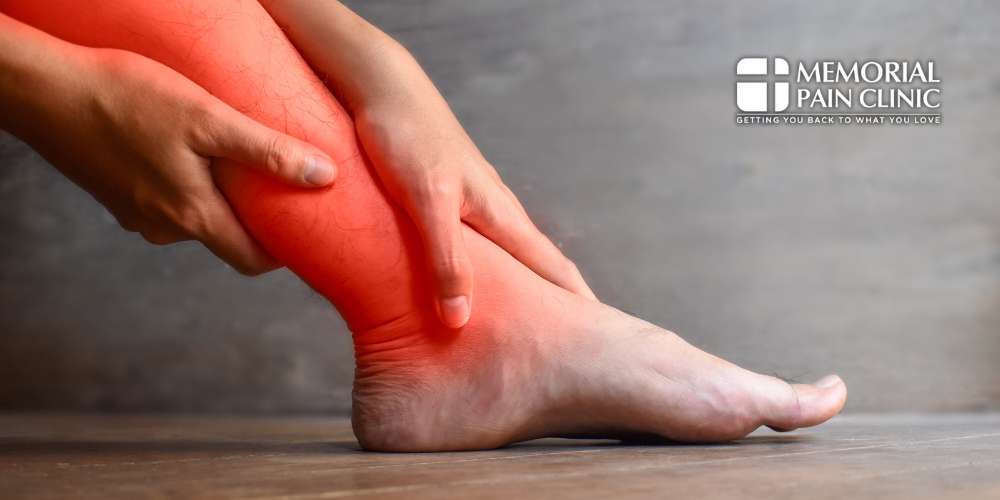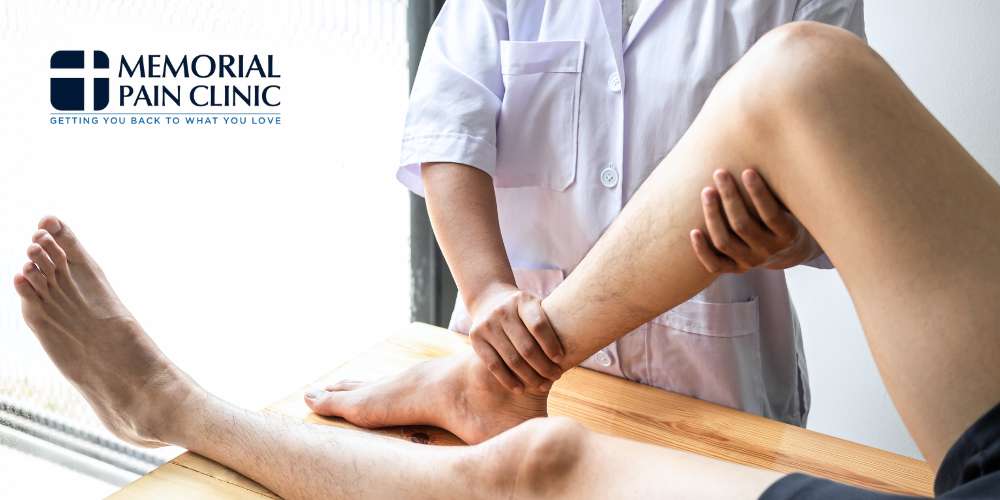What Can Cause Leg Pain?
Leg pain can range from mild pain to severe leg pain that disrupts your daily routine. Whether it’s a nagging muscle cramp or discomfort in your lower leg, paying attention to the signals your body sends is important. Leg pain may be a symptom of overuse, an injury, or something more serious, such as poor blood circulation. Understanding the source and when to worry about leg pain helps determine when to seek medical care.
Various factors contribute to leg pain, including conditions like muscle cramps or more severe vascular issues that impact your ability to function properly. At Memorial Pain Clinic in Tulsa, OK, we specialize in diagnosing and treating leg pain. Our team is dedicated to helping you find relief so you can return to what you love.
Whether your pain is mild or severe, we are here to assist you every step of the way. Call Memorial Pain Clinic at (918) 200-9944 to schedule an appointment for your leg pain treatment in Tulsa, Ok today.
Peripheral Artery Disease (PAD)
According to the U.S. Centers for Disease Control and Prevention, “peripheral artery disease (PAD) in the legs or lower extremities is the narrowing or blockage of the vessels that carry blood from the heart to the legs. It is primarily caused by the buildup of fatty plaque in the arteries. This is called atherosclerosis.” This primarily affects the lower limbs, causing cramping, pain, and fatigue during physical activity, which typically subsides with rest but returns when movement resumes.
PAD is more common in individuals over 50, particularly men, smokers, and those with high cholesterol or diabetes. Symptoms include cramping, discomfort, and fatigue in the calves, thighs, or hips, with pain potentially persisting even at rest in more severe cases. If untreated, PAD can lead to sores, infections, and, in extreme cases, amputation due to restricted blood flow.
Seek medical attention if recurring leg pain worsens during activity and doesn’t improve with rest, as the condition is a major risk factor linked to high blood pressure, high cholesterol, diabetes, and heart disease. African Americans and those over 50 are at a higher risk.
Varicose Veins
Varicose veins are swollen, twisted veins that develop when weakened valves in the veins cause blood to pool, commonly affecting the lower legs. This condition is prevalent in people who stand or sit for long periods, with pregnant women and older adults at higher risk.
Symptoms include visible, bulging veins, aching, swelling, and heaviness in the legs. Poor circulation leads to the veins enlarging and twisting. Related conditions include blood clots, venous insufficiency, and vein disease. Women, especially those with multiple pregnancies, and individuals over 50 are more susceptible.
If varicose veins cause significant pain, swelling, or skin changes, seek medical attention. Without treatment, they can lead to ulcers, blood clots, or chronic venous insufficiency, causing more swelling and discomfort.
Torn Ligaments or Muscles
Torn ligaments or muscles are typically caused by a leg injury or overuse and affect areas like the thigh, calf, or shin. Athletes and those involved in high-intensity physical activity are more prone to these injuries.
Symptoms include sudden, sharp pain, swelling, bruising, and difficulty moving the leg. These injuries occur when muscles or ligaments are overstretched or ruptured during physical activity. Without proper treatment, such as physical therapy, torn muscles can lead to chronic pain, muscle cramps, and limited mobility.
Athletes of all ages and genders are at higher risk. Seek immediate medical help if you experience sharp pain, significant swelling, or difficulty moving the leg. Left untreated, the injury can result in long-term disability.
Deep Vein Thrombosis (DVT)
Deep Vein Thrombosis (DVT) is a serious condition in which a blood clot forms in a deep vein, usually in the legs. The danger is that the clot could potentially travel to the lungs, causing a life-threatening pulmonary embolism.
Symptoms include swelling, pain, and warmth in one leg, often in the calf or thigh. DVT commonly occurs due to prolonged immobility, recent surgery, or certain health conditions. People over 60, those who are overweight, or immobile for long periods (e.g., during flights) are at higher risk.
Immediate medical attention is required if you experience sudden leg pain, warmth, or swelling. Left untreated, DVT can lead to pulmonary embolism or post-thrombotic syndrome, resulting in chronic pain and swelling.
Peripheral Neuropathy
Peripheral neuropathy occurs when the nerves that send signals from your brain and spinal cord to your legs are damaged, often due to diabetes, infections, or traumatic injuries. This painful condition typically affects the lower legs and feet, causing numbness, tingling, or sharp pain.
Symptoms include burning sensations, numbness, and shooting pain in the feet or legs. Nerve damage from high blood sugar levels or infections like Lyme disease can lead to peripheral neuropathy. People with diabetes, older adults, and those with nerve-related injuries are most affected.
Seek medical help if numbness or tingling worsens over time. Without treatment, it can lead to permanent nerve damage, loss of sensation, and an increased risk of falls or injuries.
When to See a Doctor for Leg Pain

If you’re experiencing leg pain, certain symptoms may signal it’s time to see a doctor. Swelling, sudden pain, or a burning sensation in your legs could indicate an underlying medical condition, such as plaque buildup in the arteries or even a charley horse.
Leg cramps or discomfort that doesn’t go away, or pain that radiates to other body parts, may also be early signs of more serious issues. Knowing the risk factors of common conditions like these can help you seek the right treatment before they worsen.
Pain, Swelling, and Warmth
Sudden swelling in the leg, especially if the area feels warm to the touch, is commonly associated with Deep Vein Thrombosis (DVT), a condition where a blood clot forms in a deep vein. This swelling can also indicate a blood clot elsewhere in the body and should be taken seriously. If left untreated, the clot could travel to the lungs or heart, leading to serious complications. Immediate medical attention is crucial to prevent life-threatening outcomes like a pulmonary embolism.
Fatigue and Leg Cramps
Recurring leg pain or leg cramps, especially after physical activity, may indicate conditions like peripheral artery disease (PAD) or poor blood circulation. These cramps often occur due to restricted blood flow to the muscles. In addition to PAD, varicose veins or a blood clot could be contributing factors, leading to discomfort and fatigue in the legs. If left untreated, these issues can worsen over time and affect your mobility and overall leg health.
Burning or Tingling Feelings
If you experience burning, tingling, or numbness in your legs, it could be a sign of nerve damage, such as peripheral neuropathy. These sensations often start mildly but can intensify over time, leading to chronic pain or discomfort. Left untreated, the damage can worsen, potentially resulting in long-term complications, including mobility issues or a loss of sensation in the affected areas. It’s important to seek medical attention early to prevent further nerve damage.
Sudden, Sharp Pain
A sudden, sharp pain in one leg could indicate a torn ligament, muscle strain, or even a blood clot. This type of pain often comes on without warning and can significantly limit movement. If the pain is severe and accompanied by swelling, redness, or warmth, it could be a sign of a serious issue like deep vein thrombosis (DVT), which requires immediate medical attention to prevent complications. Delaying care could lead to further injury or serious health risks.
Reduced Blood Flow
Conditions like PAD, varicose veins, and DVT restrict blood flow to the legs, causing symptoms such as fatigue, numbness, muscle cramps, and leg discomfort. These circulation issues may worsen over time, potentially leading to severe health problems like a heart attack or stroke if left untreated. In addition to these symptoms, you may also notice swelling, coldness in your lower leg, or slow-healing sores, which all point to poor blood flow and the need for medical intervention to prevent further complications.
What Are the Treatments for Leg Pain in Tulsa?

At Memorial Pain Clinic in Tulsa, OK, we provide comprehensive pain management solutions tailored to the specific cause of your leg pain. Whether it’s pain from torn ligaments, muscle cramps, or conditions affecting your blood vessels, such as peripheral artery disease (PAD) or varicose veins, our treatments focus on relieving pain and improving your quality of life. While physical therapy and surgery may be necessary in some cases, our primary goal is to offer pain care management that addresses your leg pains directly and helps restore your comfort.
At Memorial Pain Clinic, we offer the following options for pain management in Tulsa:
- Medication Management: Targeted medications reduce inflammation, relieve pain, and manage conditions like high blood pressure or PAD. In addition to medication management, monitoring your blood pressure can also lower the risk of blood clots that impact the blood vessels in your legs.
- Lumbar Epidural Injections: Epidural injections help alleviate pain in the lower back and legs caused by conditions like herniated discs or sciatica, providing relief for those who experience leg pain regularly.
- Peripheral Nerve Blocks: Nerve blocks target specific nerves to block pain signals and provide relief from chronic leg pains.
- Spinal Cord Stimulation: During a spinal cord stimulation procedure, a small device implanted near the spine sends electrical signals to disrupt pain signals, offering long-term pain relief for leg pain.
- Lumbar Facet Injections: These injections reduce inflammation and provide relief for leg pain originating from the lower back or spine, affecting the leg muscles and surrounding tissues.
- Medial Branch Blocks: A targeted injection that blocks pain signals from reaching the brain, helping to alleviate leg pain caused by nerve issues.
- Discography: A diagnostic procedure that identifies the source of pain in the spine, which may be contributing to leg pain.
- Compression Stockings: Useful for varicose veins and swelling, compression stockings improve blood circulation in the legs and reduce pain.
- Lifestyle Changes: A regular exercise routine, daily walk, and gentle stretching can strengthen leg muscles, improve circulation, and help manage leg discomfort.
- Preventative Measures: Staying hydrated, maintaining proper vein health, and managing conditions like diabetes or high blood pressure are essential to preventing future leg pain. These steps also help control plaque buildup and reduce the risk of conditions like PAD that affect the blood vessels.
Contact Memorial Pain Clinic for Leg Pain Treatment in Tulsa, OK
If you’re experiencing leg pain, it could be due to various conditions such as peripheral arterial disease, shin splints, or sudden pain related to a muscle injury. Early detection is important, as the first sign of leg discomfort can indicate more serious issues, including restricted blood flow, which may lead to chest pain or further complications.
At Memorial Pain Clinic in Tulsa, we specialize in identifying and treating the root cause of leg pain. Whether you’re dealing with mild discomfort or more severe symptoms, we offer personalized treatment plans to relieve your pain and restore mobility.
Don’t wait for your leg pain to worsen. Contact Memorial Pain Clinic today for a comprehensive evaluation and treatment. Call us at (918) 200-9944 to schedule your appointment and start your journey to relief.


